2020中考专题阅读理解(新型冠状肺炎)
文档属性
| 名称 | 2020中考专题阅读理解(新型冠状肺炎) | 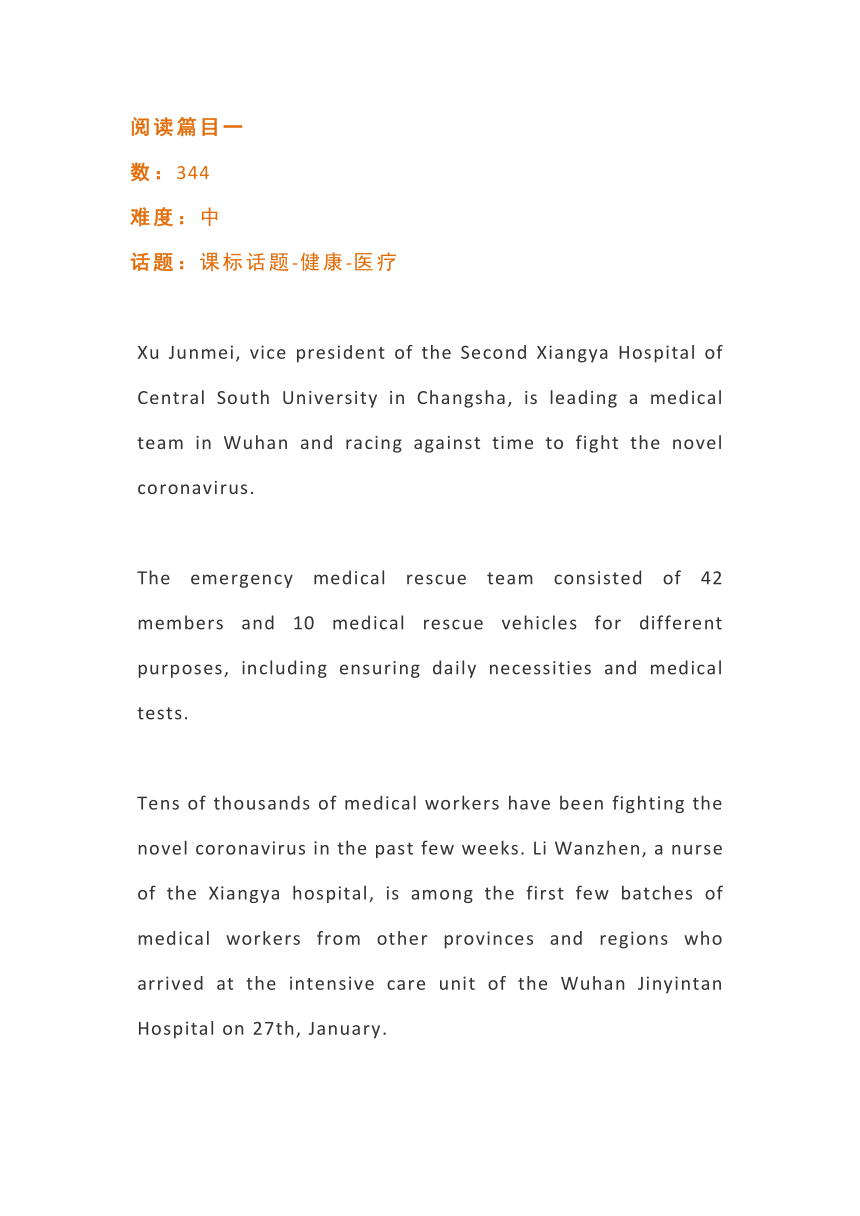 | |
| 格式 | zip | ||
| 文件大小 | 19.6KB | ||
| 资源类型 | 教案 | ||
| 版本资源 | 通用版 | ||
| 科目 | 英语 | ||
| 更新时间 | 2020-03-10 16:53:17 | ||
图片预览

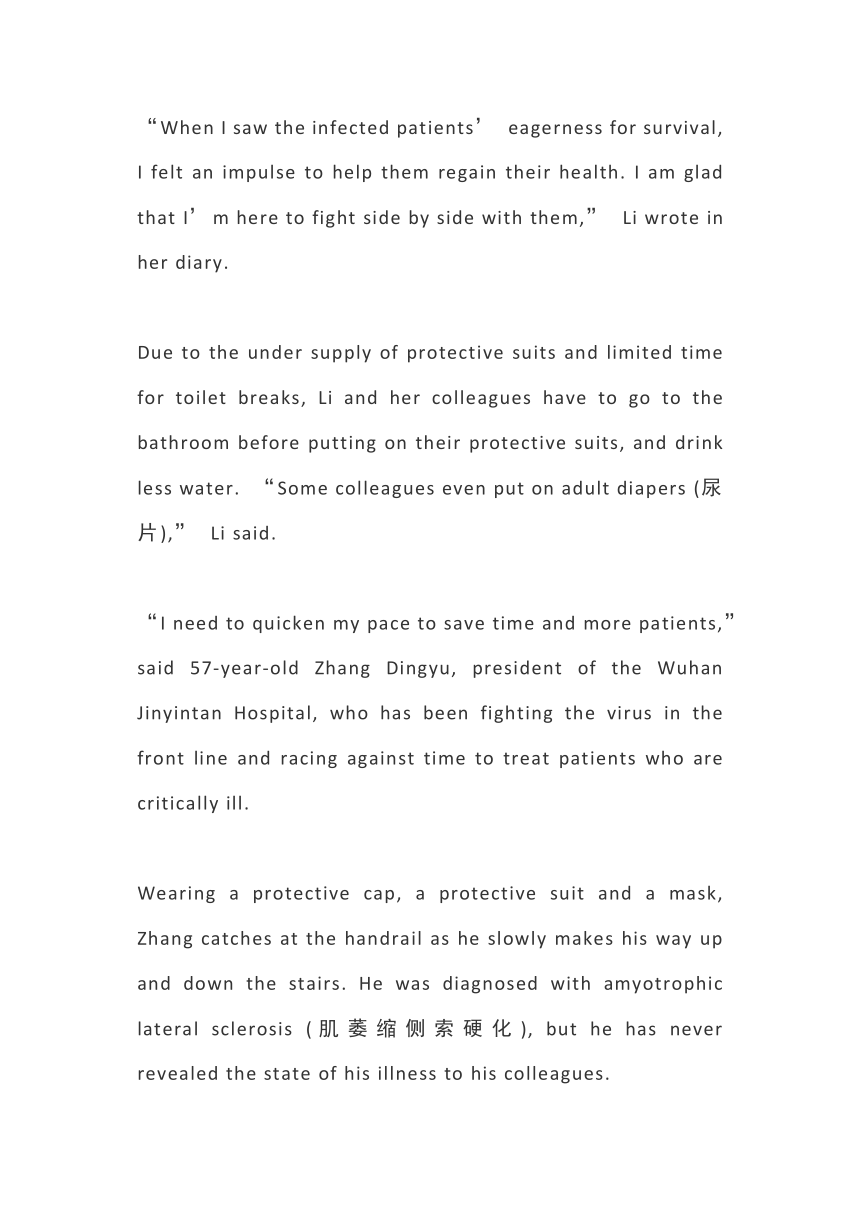
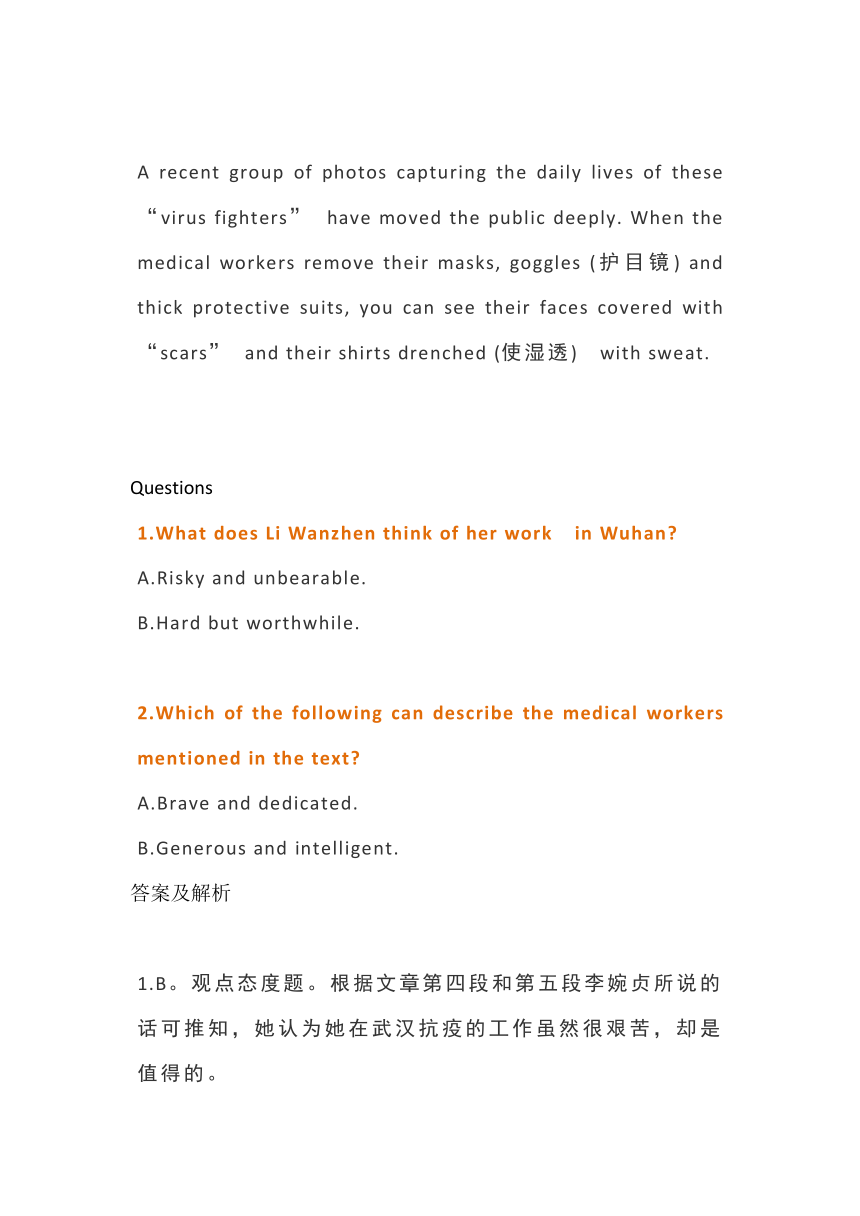
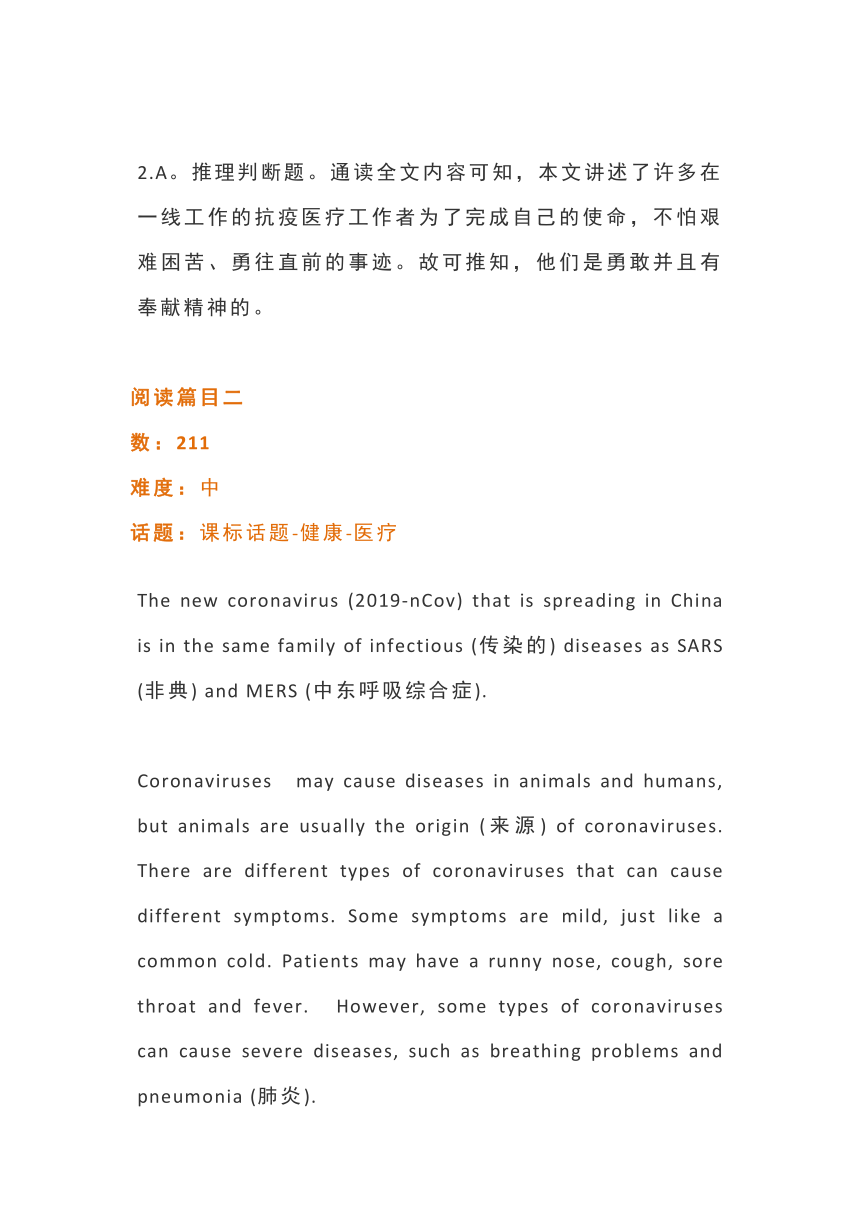
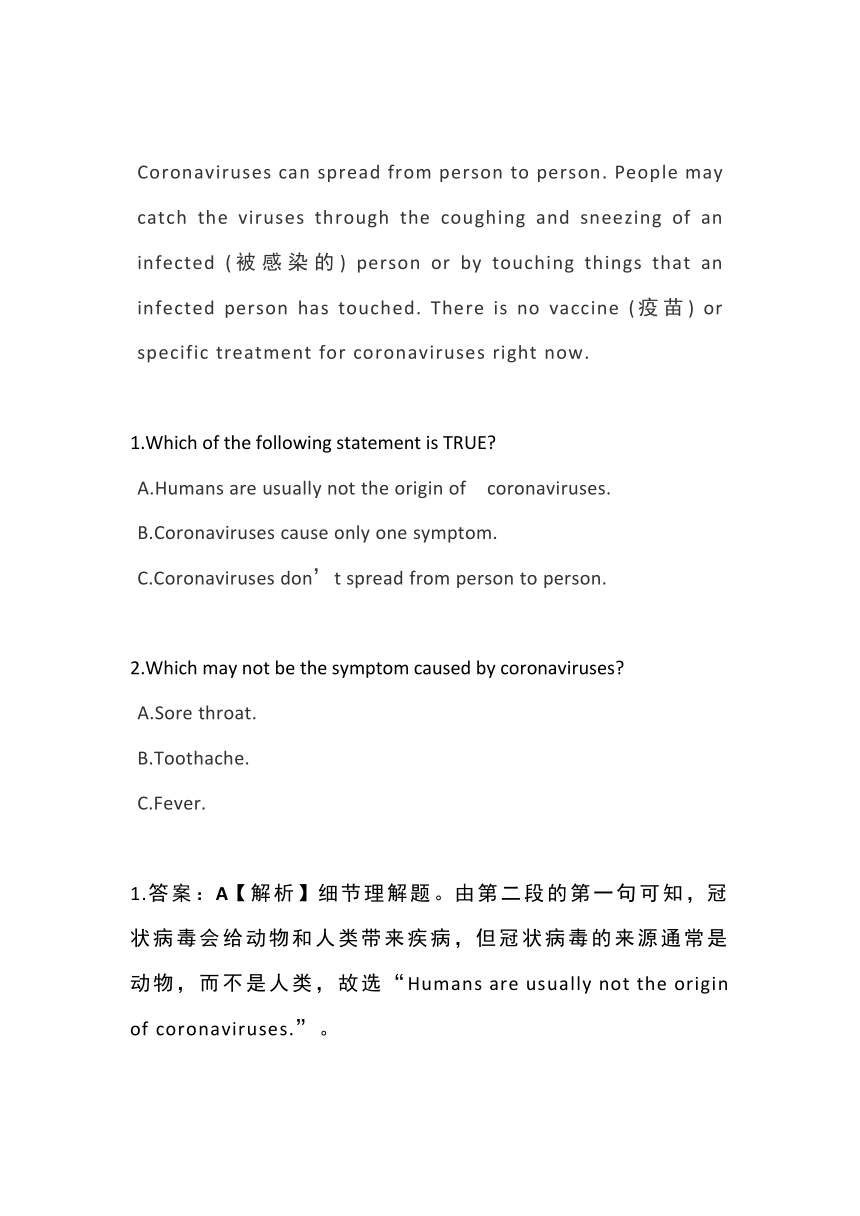
文档简介
阅读篇目一
数:344? ? ?
难度:中? ? ?
话题:课标话题-健康-医疗??
Xu Junmei, vice president of the Second Xiangya Hospital of Central South University in Changsha, is leading a medical team in Wuhan and racing against time to fight the novel coronavirus.
The emergency medical rescue team consisted of 42 members and 10 medical rescue vehicles for different purposes, including ensuring daily necessities and medical tests.
Tens of thousands of medical workers have been fighting the novel coronavirus in the past few weeks. Li Wanzhen, a nurse of the Xiangya hospital, is among the first few batches of medical workers from other provinces and regions who arrived at the intensive care unit of the Wuhan Jinyintan Hospital on 27th, January.
“When I saw the infected patients’ eagerness for survival, I felt an impulse to help them regain their health. I am glad that I’m here to fight side by side with them,” Li wrote in her diary.
Due to the under supply of protective suits and limited time for toilet breaks, Li and her colleagues have to go to the bathroom before putting on their protective suits, and drink less water. “Some colleagues even put on adult diapers (尿片),” Li said.
“I need to quicken my pace to save time and more patients,” said 57-year-old Zhang Dingyu, president of the Wuhan Jinyintan Hospital, who has been fighting the virus in the front line and racing against time to treat patients who are critically ill.
Wearing a protective cap, a protective suit and a mask, Zhang catches at the handrail as he slowly makes his way up and down the stairs. He was diagnosed with amyotrophic lateral sclerosis (肌萎缩侧索硬化), but he has never revealed the state of his illness to his colleagues.
A recent group of photos capturing the daily lives of these “virus fighters” have moved the public deeply. When the medical workers remove their masks, goggles (护目镜) and thick protective suits, you can see their faces covered with “scars” and their shirts drenched (使湿透)?with sweat.
Questions
1.What does Li Wanzhen think of her work?in Wuhan?
A.Risky and unbearable.
B.Hard but worthwhile.
2.Which of the following can describe the medical workers mentioned in the text?
A.Brave and dedicated.
B.Generous and intelligent.
答案及解析
1.B。观点态度题。根据文章第四段和第五段李婉贞所说的话可推知,她认为她在武汉抗疫的工作虽然很艰苦,却是值得的。
2.A。推理判断题。通读全文内容可知,本文讲述了许多在一线工作的抗疫医疗工作者为了完成自己的使命,不怕艰难困苦、勇往直前的事迹。故可推知,他们是勇敢并且有奉献精神的。
阅读篇目二
数:211? ? ?
难度:中? ? ?
话题:课标话题-健康-医疗?
The new coronavirus (2019-nCov) that is spreading in China is in the same family of infectious (传染的) diseases as SARS (非典) and MERS (中东呼吸综合症).
Coronaviruses?may cause diseases in animals and humans, but animals are usually the origin (来源) of coronaviruses. There are different types of coronaviruses that can cause different symptoms. Some symptoms are mild, just like a common cold. Patients may have a runny nose, cough, sore throat and fever.?However, some types of coronaviruses can cause severe diseases, such as breathing problems and pneumonia (肺炎).
Coronaviruses can spread from person to person. People may catch the viruses through the coughing and sneezing of an infected (被感染的) person or by touching things that an infected person has touched. There is no vaccine (疫苗) or specific treatment for coronaviruses right now.
1.Which of the following statement is TRUE?
A.Humans are usually not the origin of?coronaviruses.
B.Coronaviruses cause only one symptom.
C.Coronaviruses don’t spread from person to person.
2.Which may not be the symptom caused by coronaviruses?
A.Sore throat.
B.Toothache.
C.Fever.
1.答案:A【解析】细节理解题。由第二段的第一句可知,冠状病毒会给动物和人类带来疾病,但冠状病毒的来源通常是动物,而不是人类,故选“Humans are usually not the origin of coronaviruses.”。
2.答案:B【解析】细节理解题。由第二段最后两句可知,冠状病毒会引起不同的症状,包括流鼻涕、咳嗽、喉咙痛、发烧等普通感冒症状,以及呼吸困难、肺炎等更为严重的症状,所以牙痛并不是感染冠状病毒的症状,故选“Toothache.”。
阅读篇目三
数:216? ? ?
难度:中? ? ?
话题:课标话题--医疗-教育形势?
The situation of?education?
under the NCP
新型冠状病毒之下的教育形势
China’s Ministry of Education said it will carefully arrange work related to national college entrance examinations (高考), which is normally scheduled (安排) in June, to decide whether they should be postponed (延期) this year.
The work schedule will be told to the public in time, said Wang Hui, the director of the ministry’s Department of College Students Affairs.
Students who have a close relationship with the NCP patients or those having a fever or a cough, might need to be put under quarantine (隔离). Other students will need to have their health conditions checked on a daily basis, according to Wang Dengfeng, an official of the Ministry of Education.
Students from Hubei province, especially from the city of Wuhan, will not be able to leave for schools until they meet local requests, and they should be quarantined when they return to their schools, he said.
For students in the countryside, a television channel by China Education Television will start classes on Monday so they can study at home, said Lu Yugang, head of the ministry’s Department of Basic Education. These classes were not made in a hurry. Rather, they are of high quality and were carefully chosen?from courses created over the past few years, he said.?The ministry also warned schools not to make teachers overwork by requiring them to record every class?by phone.
阅读短文,根据问题选择最佳选项。
1.?Which of the following is TRUE according to the passage?
A.?The national college entrance examination?will be?postponed?this year.
B. The NCP doesn’t have effect on education.
C. Teachers should not be made to overwork.
D. Students in the countryside?can go to school to have classes.
2.??Who needn’t?be put under quarantine?according to the passage?
A. Students who have a close relationship with the NCP patients.
B. Students who have a fever or a cough.
C. Students who are in Beijing and don’t have a fever or cough.
D. Students who are from the city of Wuhan.
3.??How?can students have classes now?
A. They will go to school.
B. By TV or phones.
C. Their parents will teach them.
D. Students will go to the teachers’?home to have classes.
1.答案:C
【解析】细节理解题。根据文章第五段最后一句“The ministry also warned schools not to make teachers overwork by requiring them to record every class by phone.”可知教师不能被要求过度工作,故选“Teachers should not be made to overwork.”。
2.答案:C
【解析】推理判断题。根据文章第三段第一句“Students who have a close relationship with the NCP patients or those having a fever or a cough, might need to be put under quarantine.”,以及第四段“Students from Hubei province, especially from the city of Wuhan, will not be able to leave for schools until they meet local requests, and they should be quarantined when they return to their schools, he said.”可知和感染新型冠状病毒的患者密切接触的学生,有发烧感冒症状的学生,以及来自武汉的学生都需要隔离,由此可推断出在北京的学生且无发烧咳嗽症状的无需隔离,故选“Students who are in Beijing and don’t have a fever or cough.”。
3.答案:B
【解析】推理判断题。根据文章第五段第一句“For students in the countryside, a television channel by China Education Television will start classes on Monday so they can study at home, said Lu Yugang, head of the ministry’s Department of Basic Education.”和第五段第四句“The ministry also warned schools not to make teachers overwork by requiring them to record every class?by phone.”可推断出学生可以通过电视或者手机上课,故选“By TV or phones.”。
数:344? ? ?
难度:中? ? ?
话题:课标话题-健康-医疗??
Xu Junmei, vice president of the Second Xiangya Hospital of Central South University in Changsha, is leading a medical team in Wuhan and racing against time to fight the novel coronavirus.
The emergency medical rescue team consisted of 42 members and 10 medical rescue vehicles for different purposes, including ensuring daily necessities and medical tests.
Tens of thousands of medical workers have been fighting the novel coronavirus in the past few weeks. Li Wanzhen, a nurse of the Xiangya hospital, is among the first few batches of medical workers from other provinces and regions who arrived at the intensive care unit of the Wuhan Jinyintan Hospital on 27th, January.
“When I saw the infected patients’ eagerness for survival, I felt an impulse to help them regain their health. I am glad that I’m here to fight side by side with them,” Li wrote in her diary.
Due to the under supply of protective suits and limited time for toilet breaks, Li and her colleagues have to go to the bathroom before putting on their protective suits, and drink less water. “Some colleagues even put on adult diapers (尿片),” Li said.
“I need to quicken my pace to save time and more patients,” said 57-year-old Zhang Dingyu, president of the Wuhan Jinyintan Hospital, who has been fighting the virus in the front line and racing against time to treat patients who are critically ill.
Wearing a protective cap, a protective suit and a mask, Zhang catches at the handrail as he slowly makes his way up and down the stairs. He was diagnosed with amyotrophic lateral sclerosis (肌萎缩侧索硬化), but he has never revealed the state of his illness to his colleagues.
A recent group of photos capturing the daily lives of these “virus fighters” have moved the public deeply. When the medical workers remove their masks, goggles (护目镜) and thick protective suits, you can see their faces covered with “scars” and their shirts drenched (使湿透)?with sweat.
Questions
1.What does Li Wanzhen think of her work?in Wuhan?
A.Risky and unbearable.
B.Hard but worthwhile.
2.Which of the following can describe the medical workers mentioned in the text?
A.Brave and dedicated.
B.Generous and intelligent.
答案及解析
1.B。观点态度题。根据文章第四段和第五段李婉贞所说的话可推知,她认为她在武汉抗疫的工作虽然很艰苦,却是值得的。
2.A。推理判断题。通读全文内容可知,本文讲述了许多在一线工作的抗疫医疗工作者为了完成自己的使命,不怕艰难困苦、勇往直前的事迹。故可推知,他们是勇敢并且有奉献精神的。
阅读篇目二
数:211? ? ?
难度:中? ? ?
话题:课标话题-健康-医疗?
The new coronavirus (2019-nCov) that is spreading in China is in the same family of infectious (传染的) diseases as SARS (非典) and MERS (中东呼吸综合症).
Coronaviruses?may cause diseases in animals and humans, but animals are usually the origin (来源) of coronaviruses. There are different types of coronaviruses that can cause different symptoms. Some symptoms are mild, just like a common cold. Patients may have a runny nose, cough, sore throat and fever.?However, some types of coronaviruses can cause severe diseases, such as breathing problems and pneumonia (肺炎).
Coronaviruses can spread from person to person. People may catch the viruses through the coughing and sneezing of an infected (被感染的) person or by touching things that an infected person has touched. There is no vaccine (疫苗) or specific treatment for coronaviruses right now.
1.Which of the following statement is TRUE?
A.Humans are usually not the origin of?coronaviruses.
B.Coronaviruses cause only one symptom.
C.Coronaviruses don’t spread from person to person.
2.Which may not be the symptom caused by coronaviruses?
A.Sore throat.
B.Toothache.
C.Fever.
1.答案:A【解析】细节理解题。由第二段的第一句可知,冠状病毒会给动物和人类带来疾病,但冠状病毒的来源通常是动物,而不是人类,故选“Humans are usually not the origin of coronaviruses.”。
2.答案:B【解析】细节理解题。由第二段最后两句可知,冠状病毒会引起不同的症状,包括流鼻涕、咳嗽、喉咙痛、发烧等普通感冒症状,以及呼吸困难、肺炎等更为严重的症状,所以牙痛并不是感染冠状病毒的症状,故选“Toothache.”。
阅读篇目三
数:216? ? ?
难度:中? ? ?
话题:课标话题--医疗-教育形势?
The situation of?education?
under the NCP
新型冠状病毒之下的教育形势
China’s Ministry of Education said it will carefully arrange work related to national college entrance examinations (高考), which is normally scheduled (安排) in June, to decide whether they should be postponed (延期) this year.
The work schedule will be told to the public in time, said Wang Hui, the director of the ministry’s Department of College Students Affairs.
Students who have a close relationship with the NCP patients or those having a fever or a cough, might need to be put under quarantine (隔离). Other students will need to have their health conditions checked on a daily basis, according to Wang Dengfeng, an official of the Ministry of Education.
Students from Hubei province, especially from the city of Wuhan, will not be able to leave for schools until they meet local requests, and they should be quarantined when they return to their schools, he said.
For students in the countryside, a television channel by China Education Television will start classes on Monday so they can study at home, said Lu Yugang, head of the ministry’s Department of Basic Education. These classes were not made in a hurry. Rather, they are of high quality and were carefully chosen?from courses created over the past few years, he said.?The ministry also warned schools not to make teachers overwork by requiring them to record every class?by phone.
阅读短文,根据问题选择最佳选项。
1.?Which of the following is TRUE according to the passage?
A.?The national college entrance examination?will be?postponed?this year.
B. The NCP doesn’t have effect on education.
C. Teachers should not be made to overwork.
D. Students in the countryside?can go to school to have classes.
2.??Who needn’t?be put under quarantine?according to the passage?
A. Students who have a close relationship with the NCP patients.
B. Students who have a fever or a cough.
C. Students who are in Beijing and don’t have a fever or cough.
D. Students who are from the city of Wuhan.
3.??How?can students have classes now?
A. They will go to school.
B. By TV or phones.
C. Their parents will teach them.
D. Students will go to the teachers’?home to have classes.
1.答案:C
【解析】细节理解题。根据文章第五段最后一句“The ministry also warned schools not to make teachers overwork by requiring them to record every class by phone.”可知教师不能被要求过度工作,故选“Teachers should not be made to overwork.”。
2.答案:C
【解析】推理判断题。根据文章第三段第一句“Students who have a close relationship with the NCP patients or those having a fever or a cough, might need to be put under quarantine.”,以及第四段“Students from Hubei province, especially from the city of Wuhan, will not be able to leave for schools until they meet local requests, and they should be quarantined when they return to their schools, he said.”可知和感染新型冠状病毒的患者密切接触的学生,有发烧感冒症状的学生,以及来自武汉的学生都需要隔离,由此可推断出在北京的学生且无发烧咳嗽症状的无需隔离,故选“Students who are in Beijing and don’t have a fever or cough.”。
3.答案:B
【解析】推理判断题。根据文章第五段第一句“For students in the countryside, a television channel by China Education Television will start classes on Monday so they can study at home, said Lu Yugang, head of the ministry’s Department of Basic Education.”和第五段第四句“The ministry also warned schools not to make teachers overwork by requiring them to record every class?by phone.”可推断出学生可以通过电视或者手机上课,故选“By TV or phones.”。
同课章节目录
- 词法
- 名词
- 动词和动词短语
- 动词语态
- 动词时态
- 助动词和情态动词
- 非谓语动词
- 冠词
- 代词
- 数词和量词
- 形容词副词及其比较等级
- 介词和介词短语
- 连词和感叹词
- 构词法
- 相似、相近词比较
- 句法
- 陈述句
- 一般疑问句和否定疑问句
- 特殊疑问句及选择疑问句
- 反意疑问句
- 存在句(There be句型)
- 宾语从句
- 定语从句
- 状语从句
- 主谓一致问题
- 简单句
- 并列句
- 复合句
- 主谓一致
- 主、表语从句
- 名词性从句
- 直接引语和间接引语
- 虚拟语气
- 感叹句
- 强调句
- 倒装句
- 祈使句
- 句子的成分
- 句子的分类
- 题型专区
- 单项选择部分
- 易错题
- 完形填空
- 阅读理解
- 词汇练习
- 听说训练
- 句型转换
- 补全对话
- 短文改错
- 翻译
- 书面表达
- 任务型阅读
- 语法填空
- 其他资料
